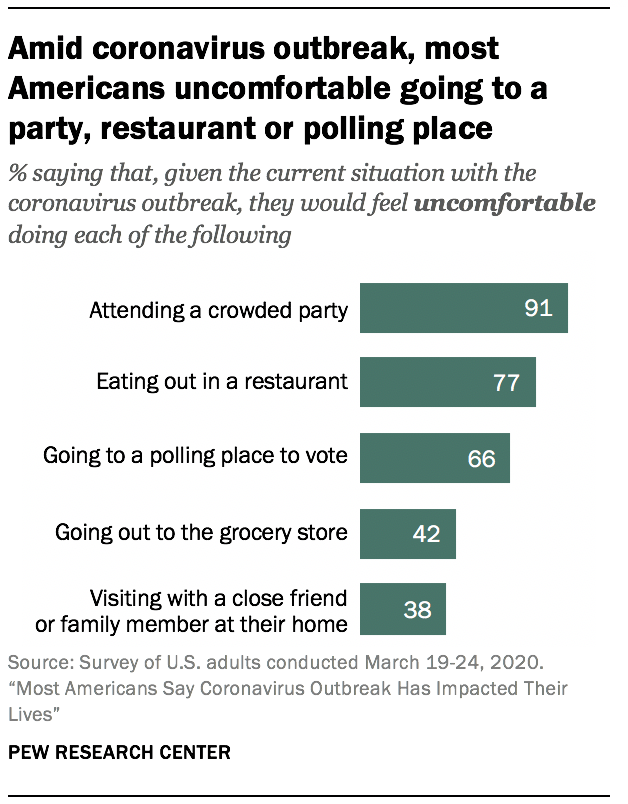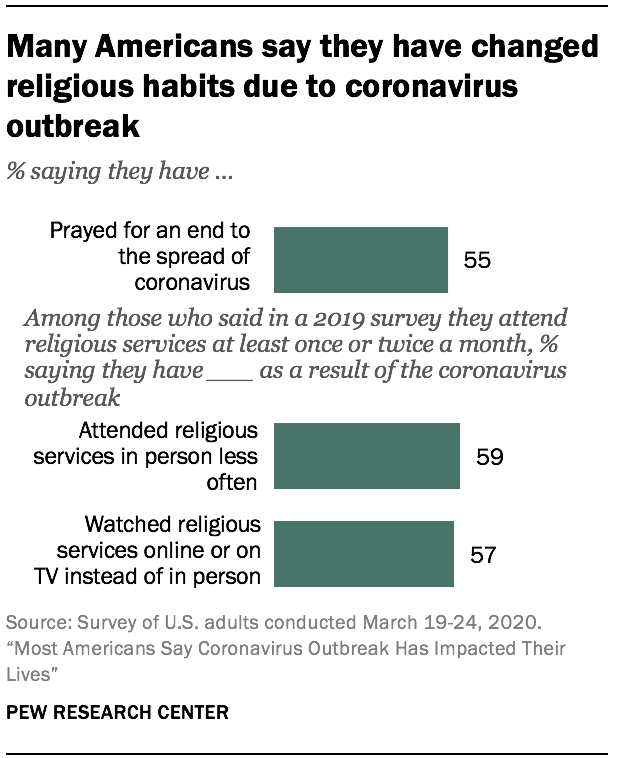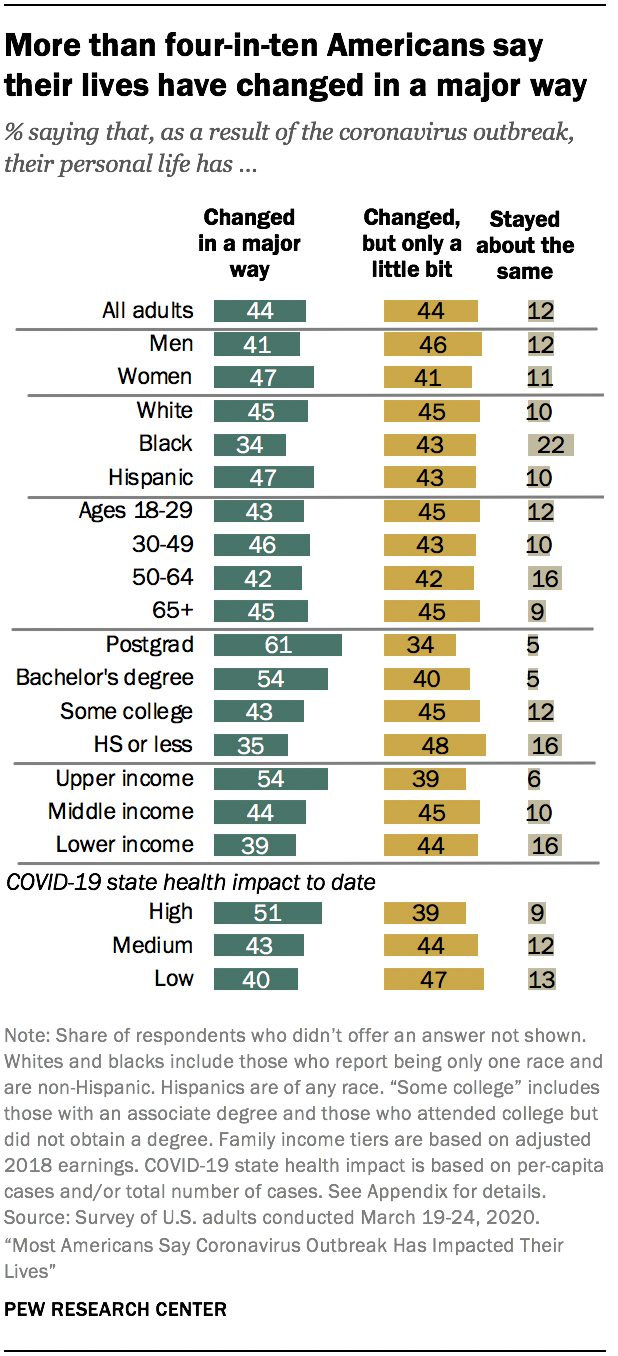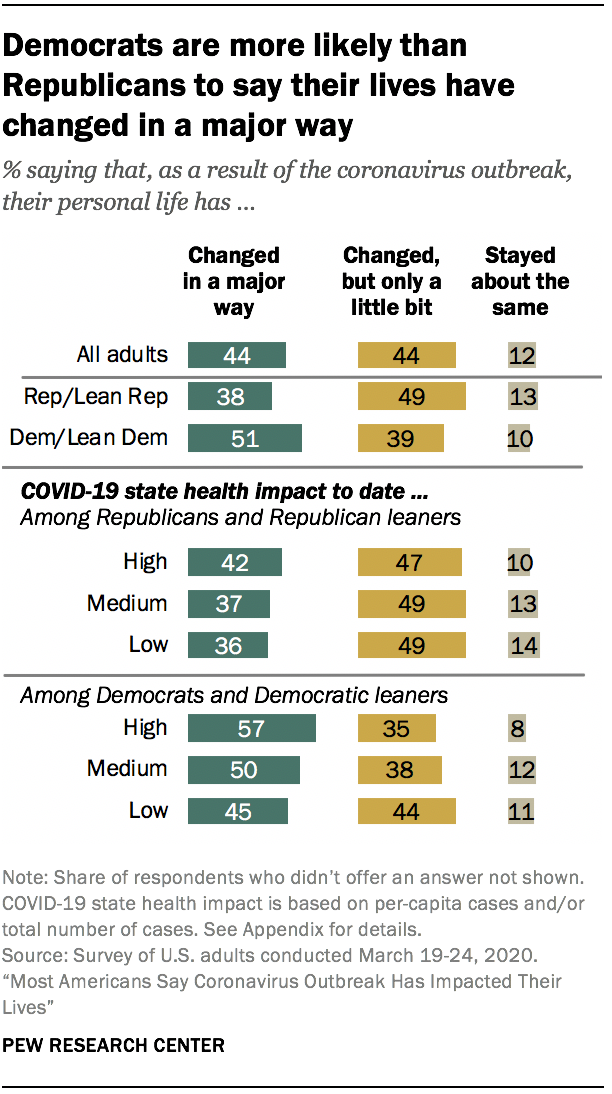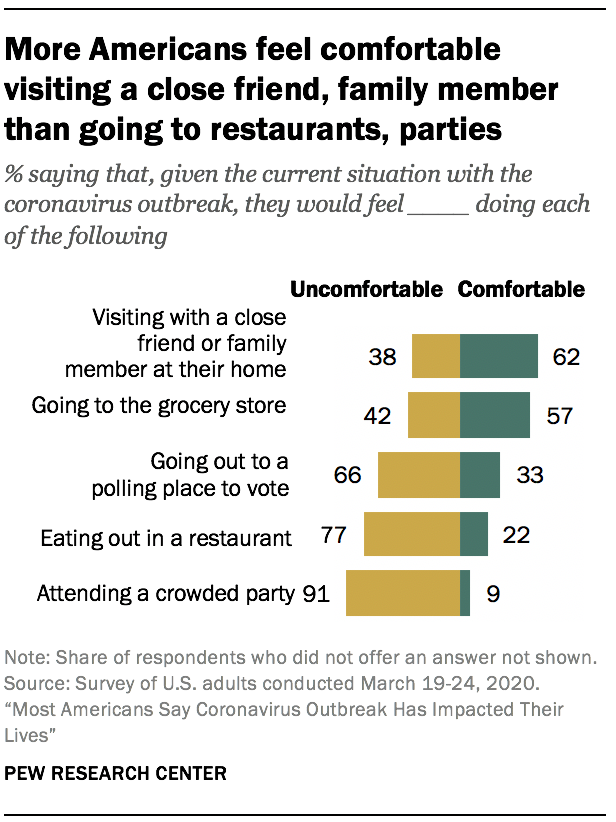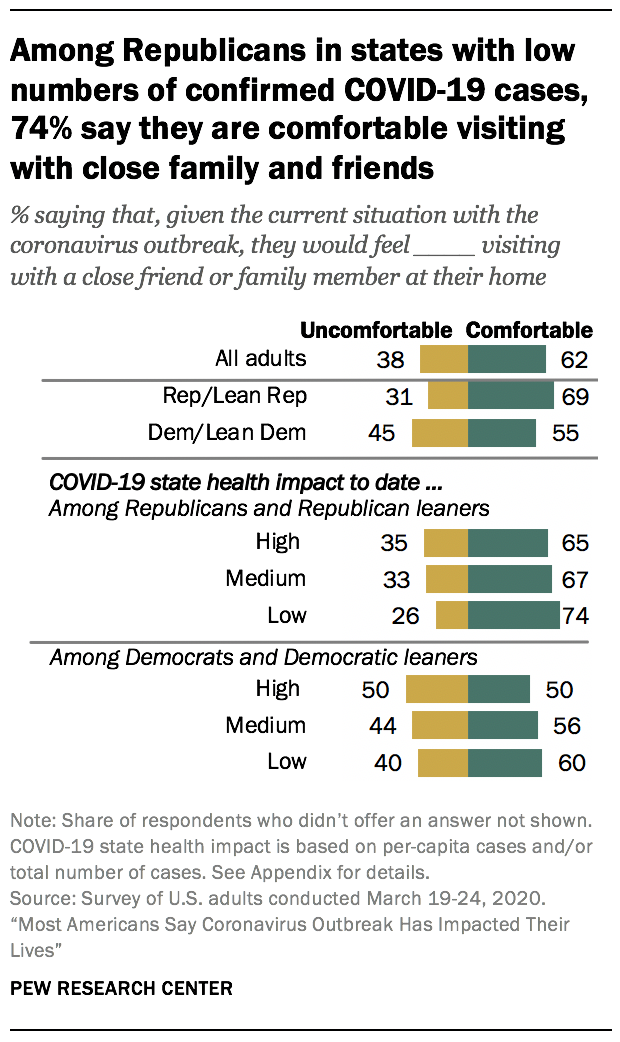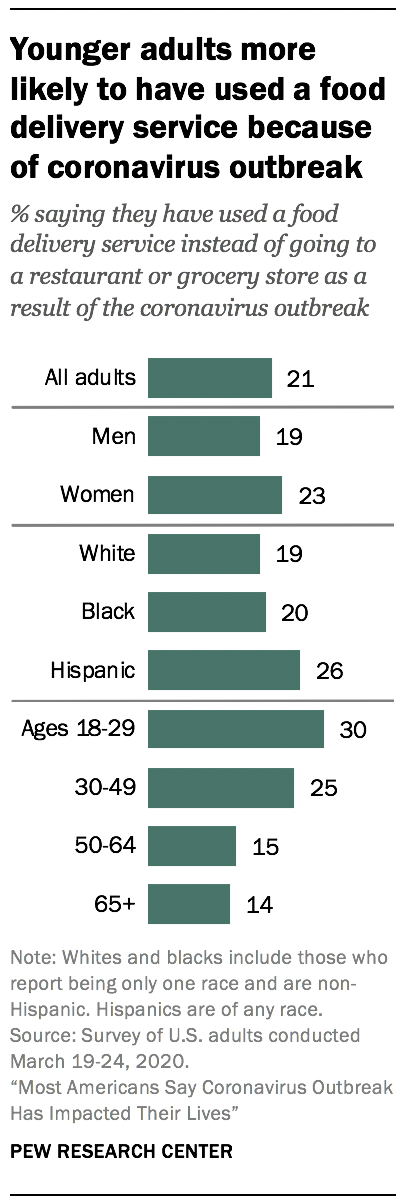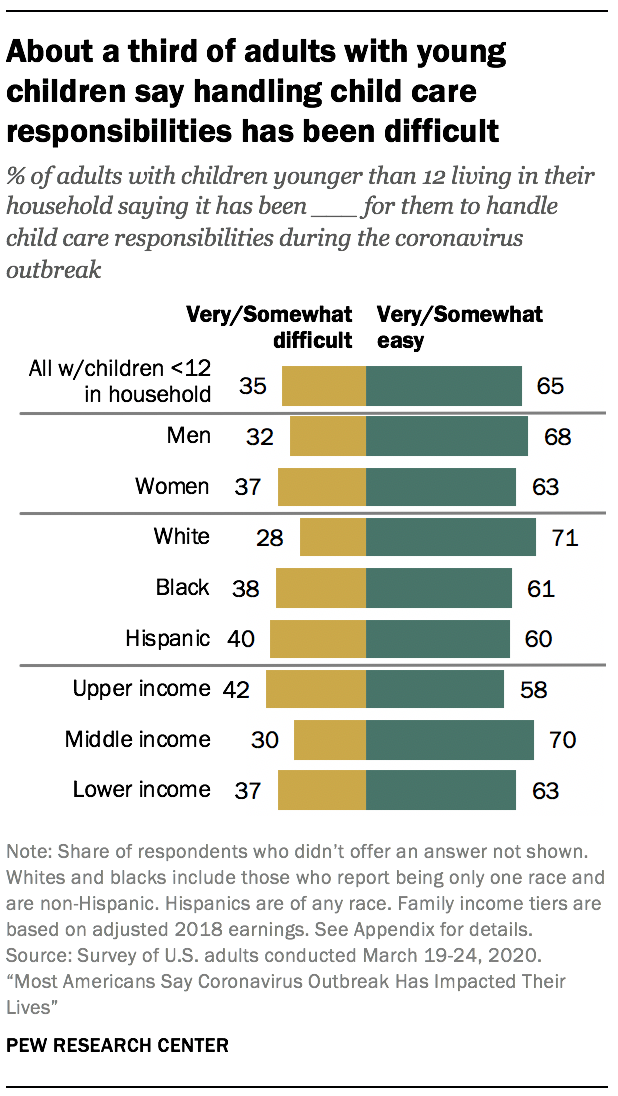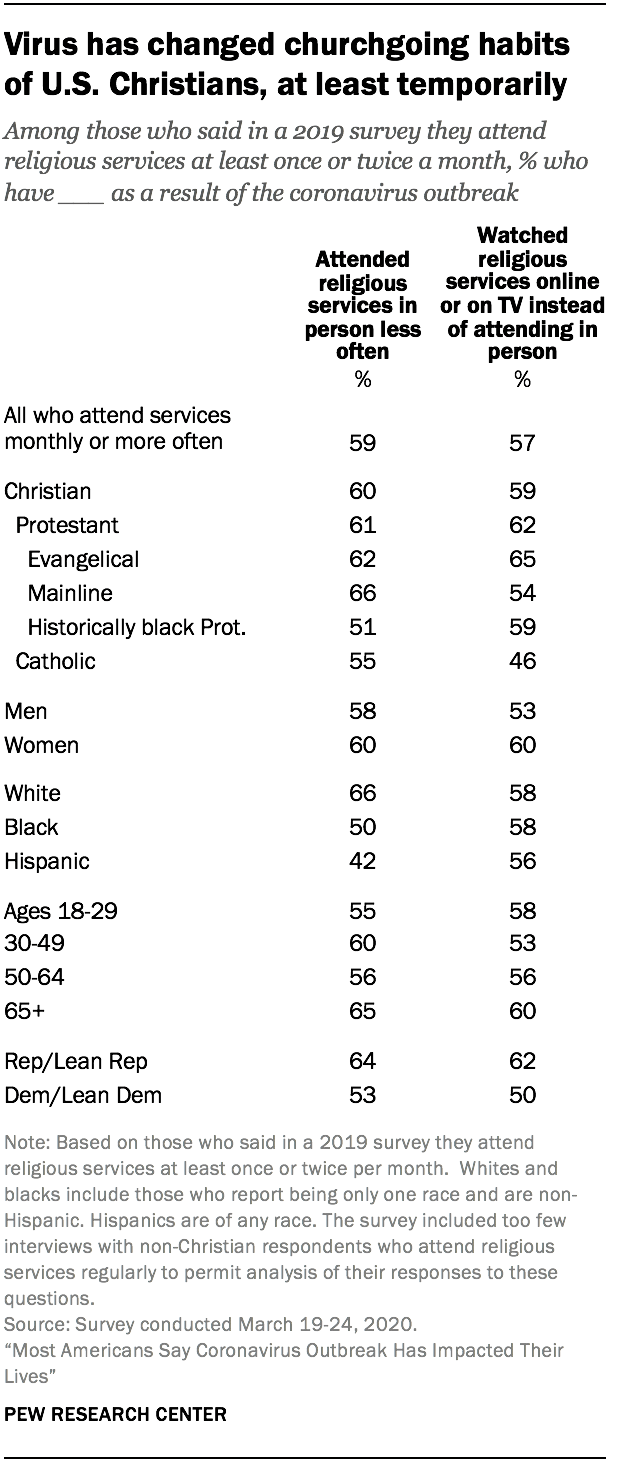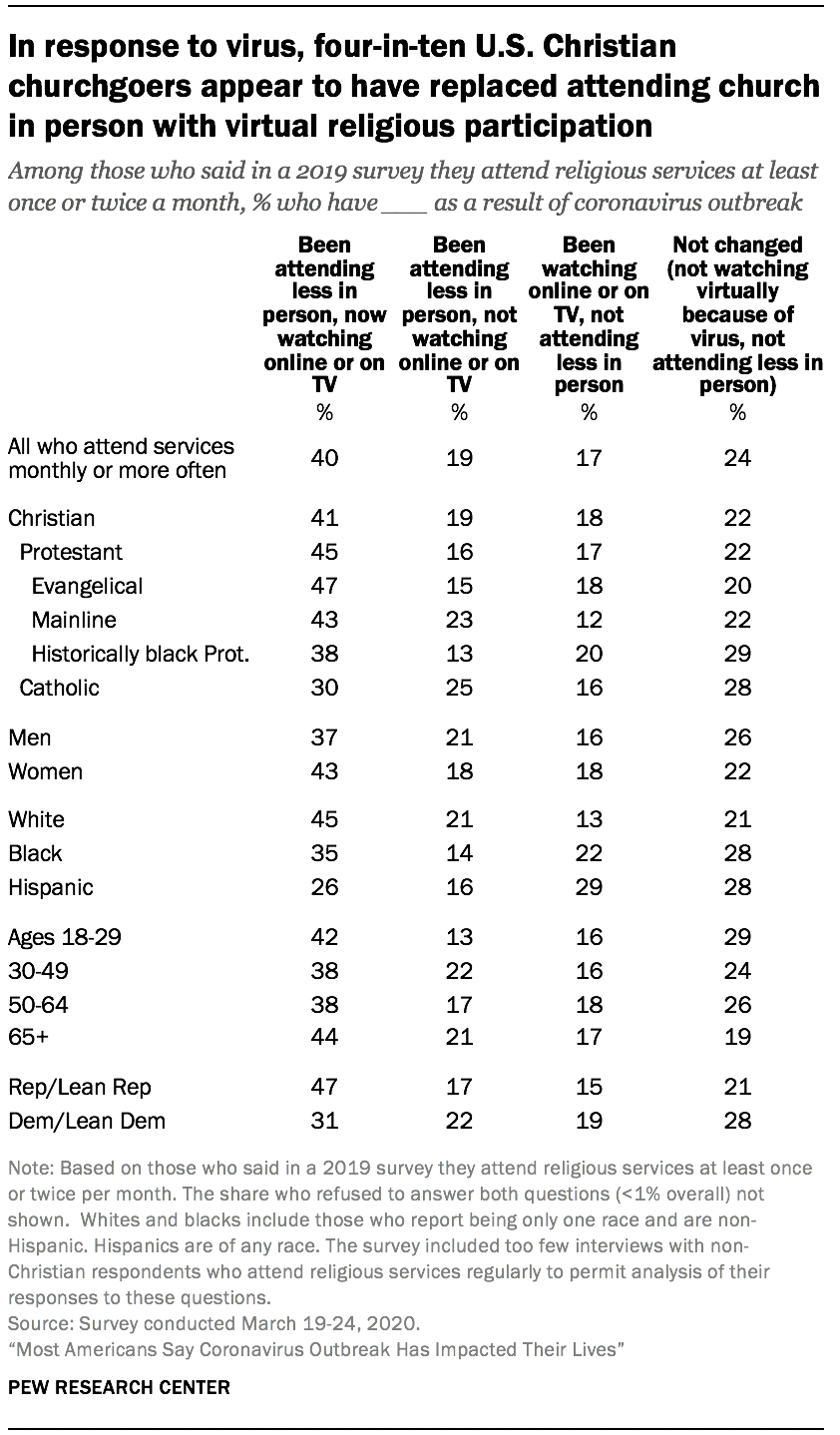Most Americans Say Coronavirus Outbreak Has Impacted Their Lives
More than half have prayed for an end to the virus’s spread
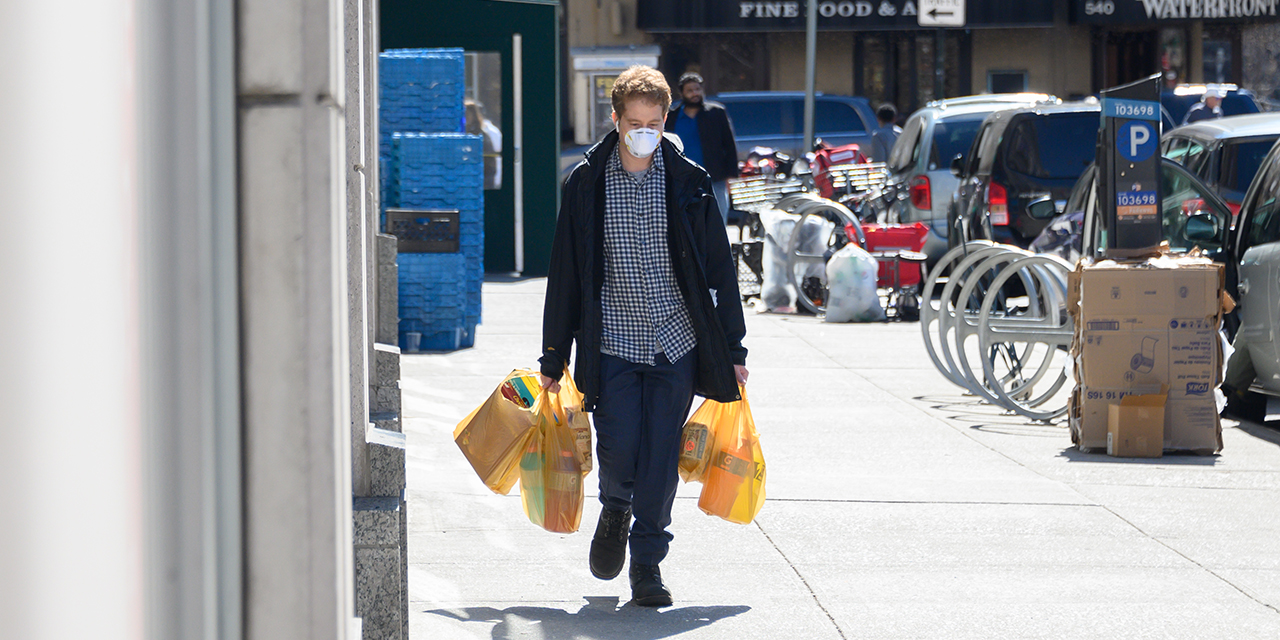
How we did this
As the number of confirmed COVID-19 cases continues to rise and schools, workplaces and public gathering spaces across the United States remain closed, a new Pew Research Center survey finds that the coronavirus outbreak is having profound impacts on the personal lives of Americans in a variety of ways. Nearly nine-in-ten U.S. adults say their life has changed at least a little as a result of the COVID-19 outbreak, including 44% who say their life has changed in a major way.
Amid widespread calls from experts for Americans to socially distance from one another to avoid spreading the virus, what recently seemed like mundane daily activities now elicit concerns from large swaths of the population. About nine-in-ten U.S. adults (91%) say that, given the current situation, they would feel uncomfortable attending a crowded party. Roughly three-quarters (77%) would not want to eat out at a restaurant. In the midst of a presidential election year, about two-thirds (66%) say they wouldn’t feel comfortable going to a polling place to vote. And smaller but still substantial shares express discomfort even with going to the grocery store (42%) or visiting with a close friend or family member in their home (38%).
How are people adapting their behavior in light of the outbreak? Four-in-ten working-age adults ages 18 to 64 report having worked from home because of coronavirus concerns – a figure that rises to a majority among working-age adults with college degrees and upper-income earners. Still, despite current circumstances, about two-thirds of adults with children under 12 at home say it’s been at least somewhat easy for them to handle child care responsibilities.
The virus also has impacted Americans’ religious behaviors. More than half of all U.S. adults (55%) say they have prayed for an end to the spread of coronavirus. Large majorities of Americans who pray daily (86%) and of U.S. Christians (73%) have taken to prayer during the outbreak – but so have some who say they seldom or never pray and people who say they do not belong to any religion (15% and 24%, respectively).
Among U.S. adults who said in an earlier survey they attend religious services at least once or twice a month, most (59%) now say they have scaled back their attendance because of the coronavirus – in many cases, presumably because churches and other houses of worship have canceled services. But this does not mean they have disengaged from collective worship entirely: A similar share (57%) reports having watched religious services online or on TV instead of attending in person. Together, four-in-ten regular worshippers appear to have replaced in-person attendance with virtual worship (saying that they have been attending less often but watching online instead).
These are among the findings of a Pew Research Center survey of 11,537 U.S. adults conducted March 19-24, 2020, using the Center’s American Trends Panel.1 Other key findings from the survey include:
- Republicans are more likely than Democrats to say they feel comfortable proceeding with a variety of activities despite the coronavirus outbreak. For example, 69% of Republicans and people who lean toward the GOP say they would be comfortable visiting with a close friend or family member at their home, compared with 55% of Democrats and Democratic leaners. Along these same lines, Democrats are more likely than Republicans to say their lives have changed in a major way as a result of the virus, and that they have been feeling psychological distress.
- Compared with older Americans, young adults are more likely to say they are comfortable going to a crowded party, a restaurant or a small gathering with close family or friends. Still, most adults under 30 say they are uncomfortable eating out at a restaurant (73%) or going to a crowded party (87%). Young adults are more likely than their elders to say they have used a food delivery service due to the outbreak.
- Concerns about public activities and changes to personal lives have been felt more acutely in states with higher numbers of COVID-19 cases. For instance, 51% of those living in highly impacted states say their lives have changed in a major way, compared with 40% of those in states with the lowest numbers of cases.
Most Americans say their personal life has been affected by the coronavirus outbreak
Nearly nine-in-ten U.S. adults say their personal life has changed at least a little bit as a result of the coronavirus outbreak, with 44% saying their life has changed in a major way. Just 12% say their life has stayed about the same as it was before the outbreak.
Women (47%) are more likely than men (41%) to say their personal life has changed in a major way as a result of the coronavirus outbreak. And while more than four-in-ten white (45%) and Hispanic (47%) adults say this has changed their lives significantly, about a third of black adults (34%) say the same.
Income and education are also linked to assessments of the personal impact of the coronavirus outbreak. More than half of those with higher incomes (54%) say this has changed their life in a major way, compared with 44% of those with middle incomes and 39% of those with lower incomes.2
Similarly, 61% of those with postgraduate degrees, and a narrower majority of those with bachelor’s degrees (54%), say the coronavirus outbreak has changed their life in a major way. By comparison, 43% of those with some college and about a third of those with a high school diploma or less education (35%) say this has happened to them. Across income groups, those with at least a bachelor’s degree are more likely than those with less education to say the coronavirus outbreak has changed their life in a major way.
Across age groups, similar shares say the coronavirus outbreak has had a major impact on their personal life. For example, 43% of adults younger than 30 say the outbreak has changed their life in a major way, as do 45% of those ages 65 and older.
Not surprisingly, those in states with a high number of coronavirus cases are more likely than those in states that haven’t been as affected to say their personal life has changed in a major way because of the outbreak. About half of those who live in states with a high number of cases (51%) say their life has changed in a major way, compared with 43% of those in states with a medium number of cases and 40% of those in states with a low number of cases.3
Among the 33% of Americans who say they or someone in their household has either lost a job or took a pay cut because of the coronavirus outbreak, 54% say their personal life has changed in a major way as a result of the outbreak. This compares with 39% of those who say they have not experienced either of these situations.
About half of Democrats say their life has changed in a major way because of the coronavirus
Democrats are more likely than Republicans to say their personal life has changed in a major way as a result of the coronavirus outbreak: About half of Democrats and Democratic leaners (51%) say this, compared with 38% of Republicans and those who lean to the GOP.
These partisan differences remain even after accounting for the fact that Democrats are more likely than Republicans to live in states with a high number of confirmed cases of COVID-19. About a third of Democrats (34%) live in these states, compared with 22% of Republicans. More than half of Democrats in states with a high number of cases (57%) say their life has changed in a major way, compared with 42% of Republicans in states with a high number of cases. Similarly, in states with a medium or low number of cases, Democrats are more likely than their Republican counterparts to say the coronavirus outbreak has impacted their life in a major way.
More than three-quarters of Americans say they are not comfortable eating out in a restaurant given the current situation with coronavirus
About six-in-ten Americans say they would feel comfortable visiting with close friends and family members at their home (62%) and going to the grocery store (57%), given the current coronavirus outbreak. Roughly four-in-ten say they would not be comfortable doing these things (38% and 42%, respectively). Far fewer express comfort in going to a polling place to vote (33%) or eating out in a restaurant (22%), and only about one-in-ten (9%) say they would feel comfortable attending a crowded party.
There are some notable demographic differences in what Americans are comfortable doing during the current outbreak. In particular, younger adults are more likely than older Americans to express comfort with leaving their homes for various reasons. Across all age groups, majorities of Americans say they are uncomfortable eating out in a restaurant; still, about one-quarter of young adults ages 18 to 29 (27%) say they would be comfortable doing this, compared with just 16% of Americans 65 and older. Younger Americans are also more likely to feel comfortable visiting with family and friends: 68% of adults younger than 30 say they’d be comfortable doing this, compared with 60% of Americans ages 30 to 49, 64% of adults ages 50 to 64 and 56% of those 65 and older.
Republicans are more likely than Democrats to feel comfortable visiting with a friend, going grocery shopping
Across a variety of measures, Republicans are more likely than Democrats to say they are comfortable continuing with regular activities. Republicans are significantly more likely than Democrats to say they are comfortable going to a grocery store and visiting friends and are far more likely than Democrats to say they are comfortable eating in a restaurant.
Roughly seven-in-ten Republicans (69%) say they are comfortable visiting with a close friend or family member at their home, while 31% say they would be uncomfortable. Democrats are more divided: 55% say they would be comfortable doing this while 45% say they would not be comfortable.
When it comes to Americans’ comfort with visiting with those close to them, partisan differences remain even after accounting for the fact that Democrats are more likely than Republicans to live in states with a high number of confirmed cases of COVID-19. About two-thirds of Republicans in states with a high number of cases (65%) say they would be comfortable visiting with close family and friends, compared with 50% of Democrats in these states. Similarly, in states with a medium or low number of cases, Republicans are more likely than their Democratic counterparts to say they are comfortable visiting with family and friends.
Overall, Americans living in suburban and rural areas are more likely than those living in urban communities to feel comfortable visiting with close friends and relatives. However, Americans living in urban areas are divided depending on how many confirmed cases of COVID-19 are in their state. Those living in urban areas in states with a high number of cases are the least likely to feel comfortable visiting with others (47%) while urban dwellers in states with a medium (56%) or low (67%) number of cases are more likely to feel comfortable going out to visit friends. These differences are not as stark in suburban areas, and there is no difference in comfort with visiting others among Americans in rural communities, regardless of the number of cases in the state.
About one-in-five adults say they have used a food delivery service because of the coronavirus outbreak
Amid recommendations for social distancing to help prevent the spread of COVID-19, about one-in-five adults (21%) say they have used a food delivery service instead of going to a restaurant or grocery store as a result of the coronavirus outbreak.
Adults younger than 30 are particularly likely to say they have used a food delivery service because of the coronavirus outbreak: Three-in-ten in this group say they have done this. A quarter of adults ages 30 to 49 also say they have used a food delivery service because of the coronavirus outbreak, while smaller shares of those ages 50 to 64 (15%) and those 65 and older (14%) say the same.
Hispanic adults (26%) are more likely than white (19%) and black (20%) adults to have used a food delivery service instead of going to a restaurant or grocery store as a result of the coronavirus outbreak. And while about a quarter of women (23%) say they have done this, about one-in-five men (19%) say the same. There are no notable differences by educational attainment, income, or whether people live in states with a high, medium or low number of coronavirus cases.
Most working-age adults with at least a bachelor’s degree have worked from home as a result of the coronavirus outbreak
Four-in-ten working-age adults – those ages 18 to 64 – say they have worked from home as a result of the coronavirus outbreak.4 Men and women in this age group are about equally likely to say they have worked from home.
About three-quarters of working-age adults with a postgraduate degree (73%) say they have worked from home as a result of the coronavirus outbreak, as do 62% of those with a bachelor’s degree. Far smaller shares of working-age adults with some college (35%) or with a high school diploma or less education (22%) say they have worked from home.
Similarly, working-age adults with higher incomes are more likely than those with lower incomes to say they have worked from home because of the coronavirus outbreak: 61% of those in the upper-income tier say they have done this, compared with 41% in the middle-income tier and an even smaller share (27%) of those with lower incomes.
In states with a high number of coronavirus cases, 45% of working-age adults say they have worked from home because of the outbreak; smaller shares in states with a medium or low number of cases say the same (38% each).
Most adults with young children at home say it has been easy for them to handle child care responsibilities
Even as many schools have closed because of the coronavirus outbreak, 65% of adults with children younger than 12 at home say it has been at least somewhat easy for them to handle child care responsibilities during this time, with 32% saying it has been very easy. About a third (35%) say this has been very or somewhat difficult for them.
Similar shares of men (68%) and women (63%) with young children at home say it has been easy for them to handle child care responsibilities during the coronavirus outbreak (the difference between the shares of men and women saying this is not statistically significant).
Black and Hispanic adults with children younger than 12 at home are more likely than white adults with children in the same age group to say handling child care responsibilities has been difficult for them during the outbreak: About four-in-ten black (38%) and Hispanic (40%) adults with young children say this, compared with 28% of their white counterparts. Still, majorities of at least six-in-ten in each group say it has been easy for them to handle child care responsibilities during this time.
Majorities across income groups also say handling child care responsibilities has been at least somewhat easy for them so far, but those with middle incomes are more likely than those with upper or lower incomes to say this. Seven-in-ten middle-income adults with children younger than 12 at home say it’s been easy for them to handle child care responsibilities, compared with 58% of those in the upper-income tier and 63% in the lower-income tier.
Many Americans are praying and staying away from religious services in response to coronavirus
More than half of U.S. adults say they have prayed for an end to the spread of the coronavirus. Evangelical Protestants are among the most likely to say they have prayed for an end to the virus (82% say they’ve done so). A similar share of adherents of the historically black Protestant tradition (79%) say they have done the same. Two-thirds of Catholics (68%) and mainline Protestants (65%) also say they have prayed for an end to the outbreak.
Roughly one-third of Jews (35%) say they have prayed to end the virus. Religious “nones” – especially self-described atheists and agnostics – are less likely than those who identify with a religion to say they have prayed for an end to the outbreak, though 36% of those who describe their religion as “nothing in particular” say they have prayed about the virus.
Fully 86% of people who pray every day say they have prayed specifically about the virus, as have two-thirds of those who say they pray on a weekly basis. Half of those who say they pray a few times a month report having prayed about the coronavirus, as have 15% of those who generally seldom or never pray.
More women than men say they have prayed for an end to the spread of the disease, and more black respondents than white and Hispanic respondents say the same. Older people are more likely than younger adults to say they have prayed for an end to the virus, and more Republicans than Democrats have prayed about the outbreak. These patterns are consistent with overall differences in the religiousness of these groups.
The survey also shows that the outbreak has changed the religious attendance habits of U.S. adults, at least for the time being. Among people who said in a previous survey that they generally attend religious services at least once or twice a month, 59% now say they have attended less often recently as a result of the outbreak. And a similar share (57%) say they have watched religious services online or on TV instead of in-person.5
Across Christian groups, half or more of those who typically attend church at least monthly say they have been going less often because of the virus. Many of them – including two-thirds of evangelical Protestants – say they have tuned in to church services online or on television instead of attending in person.
Women who attend worship services monthly or more often are a bit more likely than men who attend with the same frequency to say they have turned to the internet or television to watch religious services (though no more likely to say they have been attending less often in-person). White church attenders are more likely than blacks and Latinos to say they have attended less often. Higher shares of Republicans than Democrats say they have stayed away from religious services and that they have turned to virtual alternatives in reaction to the outbreak.
Combining the two questions suggests that four-in-ten Americans who typically attend religious services at least monthly appear to have replaced their in-person attendance with virtual religious participation; 40% say they have been attending religious services less often and that they have been watching them online or on television instead as a result of the outbreak. One-in-five (19%) are attending less often but not replacing in-person attendance with watching services electronically, and 17% appear to be supplementing their in-person attendance with virtual participation (i.e., they say they are not attending less but that they are watching online or on TV). One quarter of those who typically attend religious services monthly say their attendance habits have not changed – they are not attending less often, nor are they watching services online or on television.
Among those who typically attend church at least monthly, the share of Christians who indicate they have replaced in-person attendance with watching church services online or on TV tops out at 47% among evangelical Protestants. White people are more likely than black and Hispanic respondents to say they are now watching religious services online while attending less in person, while black and Hispanic people are more likely than white respondents to say they are supplementing their in-person attendance with virtual religious participation or that their attendance habits have not changed.
CORRECTION (April 1, 2020): A previous version of the first chart in the report had an incorrect percentage for the share of Americans who would feel uncomfortable going out to the grocery store. It should have been 42%. This change does not substantively affect the report’s findings.
- For more details, see the Methodology section of the report. ↩
- Family incomes are based on 2018 earnings and adjusted for differences in purchasing power by geographic region and for household sizes. Middle income is defined here as two-thirds to double the median annual income for all panelists. Lower income falls below that range; upper income falls above it. ↩
- COVID-19 state health impact is based on per-capita cases and/or total number of cases. See Appendix for details. ↩
- This analysis includes all working-age adults ages 18 to 64, including some who may not be employed. ↩
- The questions that ask respondents whether they have been attending religious services less often or watching them online or on TV instead of attending in-person were asked of everyone. Among all respondents, 27% say they have attended religious services less often and 25% (including 11% who generally attend religious services a few times a year or less) say they have watched them online or on TV in response to the outbreak. To facilitate interpretation of these data, the analyses reported here are based on those who said in a previous survey (conducted in the summer and fall of 2019) that they generally attend religious services at least once or twice a month. Those who indicated in the previous survey that they attend religious services a few times a year or less often may report low levels of having attended less often or having watched online in response to the virus because they attended sporadically or not at all to begin with, not because they are unconcerned by the virus. The survey included too few interviews with non-Christian respondents who attend religious services regularly to permit analysis of their responses to these questions. ↩

